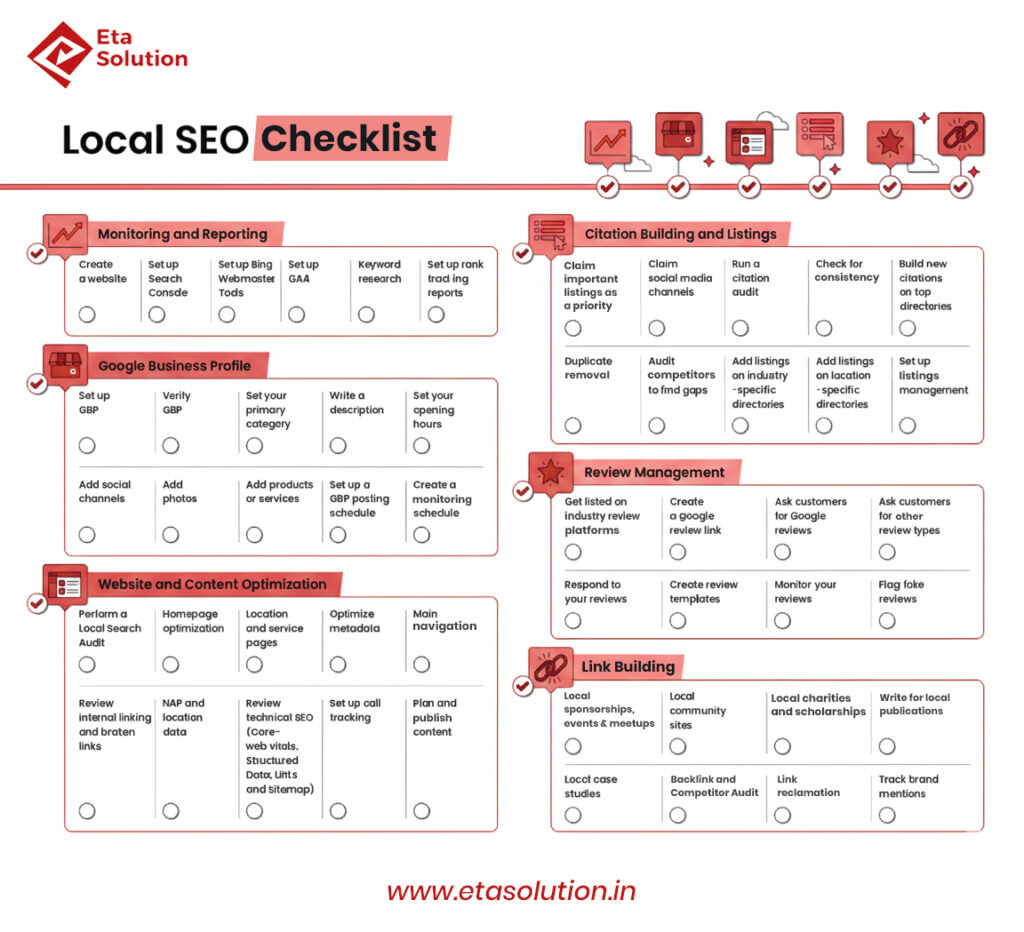
How to Perform a Comprehensive Local SEO Audit
In case your company is featured on the third page of local search results, then you are practically non-existent to the majority of customers, and this situation cannot be accepted anymore. A dull showing in the local map pack results in fewer leads, less foot traffic, and weaker trust signals. Actually, a study indicates that approximately 80% of American consumers look for a local business online at least once a week, and 32% do it daily. Given such a high game, a local SEO audit done in a systematic way is not merely an option. It is the tool that helps you see if your visibility is working in your favor or not.
We will take you through all the essential elements of a comprehensive audit so that you can assess, rectify, and optimize for local search presence.
Local SEO Audit Checklist and Why It’s Important
A local SEO audit is a structured review of Being on the third page of local search results makes your business invisible to most customers, and that is no longer acceptable. A mediocre local map pack presence means leads going to your competitors, less in-store traffic, and a decrease in your trustworthiness. Actually, the statistics reveal that around 80% of consumers in the USA make an online local business search once a week, and 32% do it daily. At such a high level, a small business SEO audit is definitely not optional. It is the tool you use to make sure your visibility is aiding you, not harming you.
We will bring you through the essential parts of a complete audit so that you can assess, fix, and advance your local search presence.
What Local SEO Audit Is and Why It’s Essential
Local SEO audit is an organized examination of the factors that influence the appearance of your business in local searches and map pack.all the elements that affect how your business appears in local searches and the map pack. You’re reviewing everything that influences how search engines perceive and rank your business for geographically-targeted queries. As one guide puts it, “a full local SEO audit can take dozens of assets and signals into account.”
Why does this matter? Because if you ignore local signals, you’ll get few clicks, calls, or visits even if your product is excellent. According to BrightLocal, 42% of searchers click on map-pack results for local queries.
The audit gives you:
- Visibility into weaknesses
- Concrete action steps to improve rankings and drive traffic
- A benchmark so you can measure progress over time
If you’re the marketing lead for a brand or you run an agency offering local services in India or beyond, this audit framework is exactly what you need to deliver or implement.
Local SEO Made Simple: Checklist for Higher Local Search Rankings

Analysing Google Business Profile Optimization
Your Google Business Profile audit is the front door to local search. If this is weak, you’ll struggle in the “local search optimization” game.
Check that:
- Your business is verified, and the profile is claimed.
- The business name, address, phone number, and category are set correctly
- You’ve chosen the most relevant primary and secondary categories.
- Your description uses local keywords naturally, not stuffed
- Hours, website link, and service area are up-to-date
- You regularly post updates/photos and respond to reviews
For an SEO company in Ahmedabad, this means specifying your city, state, services, and ensuring you’re listed under a relevant category like “Digital marketing agency” or “SEO agency” rather than a vague one.
Even if you get everything else right, a poorly optimised GBP will hold everything back.
Checking NAP Consistency
NAP – Name, Address, Phone number – might feel trivial, but it isn’t. Inconsistent or outdated NAP data is one of the most common and damaging issues in local audits.
Key steps:
- Extract your business name, full address including city/state, and phone number as you use them.
- Search across major listing sites and industry niche sites.
- Identify mismatches: e.g., “Ahmedabad, Gujarat” vs. “Ahmedabad, GJ”; missing suite numbers; old phone numbers.
- Fix duplicates or conflicting listings.
- Ensure your website’s “Contact” page matches the GBP exactly, and apply structured data on-site.
This audit portion is foundational without a consistent NAP; the other local optimization efforts may not fully “register” with Google or result in sliding rankings.
Reviewing Local Citations and Directory Listings
A “citation” means any mention of your business name + address on another website. A proper citation audit checks how many and how accurate those references are. This supports “audit local listings” and is critical for trust signals.
Why it matters:
- Citations increase signal strength in local search engines.
- Low-quality or inconsistent directory listings can hurt.
- Industry-specific directories provide stronger value than generic ones.
What to check:
- List of where your business appears
- Accuracy of each listing
- Remove or merge duplicates
- Add your listing in missing but relevant local & industry directories
- Monitor for any brand or listing mentions that don’t link
For example, a national campaign by a local business found that cleaning up 50 inconsistent citations improved their Google Maps ranking factors by 2 spots within 90 days.
Evaluating On-Page SEO for Local Landing Pages
“On-page local SEO” means the adjustments you make to your website so local search engines clearly understand you serve a particular area and services.
Audit steps:
- Does your homepage or service page include the city, state, and local context?
- Is there a dedicated landing page for your NGO/brand if you serve multiple locations?
- Titles, H1s, meta descriptions: Do they reflect local relevance?
- Schema markup: Use LocalBusiness schema properly.
- Embedding a Google Map of your location adds both UX and SEO credibility.
- Responsive design and page speed: which we’ll cover deeper later.
- Internal linking and citations to your location pages.
Including local landmark or neighbourhood content helps with “proximity” signals.
Auditing Local Keywords and Search Intent
You need to perform a “local keyword audit,” that is, identify which geo-targeted keywords your audience uses, and map them into your content and profiles.
Steps:
- Pull your existing keywords: use Search Console or tools to see which queries bring impressions in your city/region.
- Brainstorm locational modifiers: e.g., “SEO company in Ahmedabad”, “top SEO agency Ahmedabad”, “local SEO services Gujarat”.
- Categorise by intent:
- Informational
- Transactional
- Ensure your GBP profile, website content, and directory listings reflect the keywords naturally.
- Check search intent: if someone types “SEO company in Ahmedabad cost”, they’re comparing pricing; your content needs to address that.
Industry insiders note that keyword clusters around service-area + “near me” variations are rising; don’t ignore them.
Assessing Customer Reviews and Online Reputation
Reviews are more than ego boosts; they’re serious local ranking signals. For the map pack ranking, reviews matter significantly.
Audit focus:
- Total number of reviews on GBP and major directories
- Average star rating and trend over the past 6-12 months
- Review content: Does it mention local keywords or services? This matters for contextual relevance.
- Response behaviour: Do you reply to reviews? This shows active management.
- Whether negative reviews are unresolved or hanging.
- Reputation on third-party platforms as well.
Create a review-request process to increase volume post-service, and track improvement monthly.
Analysing Backlinks and Local Link-Building Opportunities
Sometimes local audits skip backlinks. Don’t. For “local backlink analysis”, you must evaluate the strength of your website’s link profile as it relates to the geographic service area.
Audit checklist:
- Utilize a link-analysis tool to set a baseline for the number of backlinks, referring domains, and domain authority.
- Find backlinks that are relevant to the local area, for example, local news, local business partners, and local sponsorships
- Contrast to rivals: what is the count of local links that they have in comparison to you?
Opportunity hunt:
- Local chamber of commerce website
- Local blogs or newspapers
- Industry or city-specific directories
- Events sponsorships
- Check for spam or toxic links: disavow if needed.
- Local brand campaigns reveal that merely sprinkling 5 top-notch local backlinks to a brand in a month led to an increase of 1-2 positions in map-pack visibility for service-area businesses.
- Experimenting with Mobile-Friendliness and Page-Loading Speed
- When your website is slow on mobile, your local audit will definitely highlight it as a serious problem. The majority of local searches are done on mobile devices and are very time-sensitive.
Testing suggestion:
- Employ Google’s Mobile-Friendly Test and PageSpeed Insights
- Load time – aim: under 3 seconds
- Navigation ease: Can a mobile user tap “Call” from your landing page?
- Check for indexation issues: does your service-area page get properly crawled and rendered?
- Embed map or contact details clearly; ease of conversion matters.
Local search optimisation increasingly prioritises UX signals, especially for mobile.
Using SEO Tools to Track and Measure Local Performance
You can’t improve what you don’t measure. Having a suite of able “local SEO tools” is part of your audit and ongoing regime.
Tools & metrics to consider:
- Rank-tracking tool with local/geo support: track your position in local SERPs and in the map pack
- GBP Insights: monitor how users found you, queries used, actions taken
- Citation-audit tools: detect inconsistent NAP, duplicates
- Review monitoring tools: track volume, sentiment, rating trends
- Backlink-analysis platform: track new/ lost links, domain authority
- Speed and mobile usability tools
- Spreadsheet dashboard: monthly snapshot of key metrics
As part of your Best Digital Marketing Agency in Ahmedabad offering, maintain a live dashboard that clients can view, which builds trust and transparency.
Closing Take
A comprehensive local SEO audit isn’t sexy, but it’s foundational. Done properly, it illuminates weak spots from your GBP listing to citations, from reviews to backlinks, from page speed to local-keyword alignment. If you skip one piece, you risk undermining everything else.
Business owners, marketing executives, agencies: consider this audit as your new standard. Fix a complete assessment every quarter, follow up with upgrades, and keep refining. The reason is, when your local presence is actually effective, you will experience not only clicks, but significant calls, walks, and expansion.
Here’s a question to leave you with: after your next audit, if your business still isn’t rising into the map-pack or your keywords aren’t working, what will you stop doing instead of what you’ll start doing?
Use an impact × effort matrix:
Quick wins, high impact: Fix GBP issues, NAP inconsistencies, critical technical errors, schema for main pages.
Medium effort, medium impact: Create unique location pages, optimize title/meta for local keywords, review response program.
Long term, high impact: Build local links, content/authority strategies, reputation management.
Start with items that directly affect indexing and GBP, then move to content and link building.
At minimum, perform a full local SEO audit quarterly for active businesses and biannually for low-activity ones. Monitor GBP, reviews, and citations monthly. Frequency depends on:
Competitive intensity of your local market.
Number of locations (more locations = more frequent checks).
How often you publish content or change business info.
Regular audits let you catch data drift (e.g., wrong hours, new duplicate listings) before they affect rankings.
Local keyword audit steps:
Compile keyword list including geo-modifiers, “near me” queries, service + neighborhood phrases.
Use Google Search Console and GBP Insights to see real queries sending impressions.
Run competitor analysis to see which keywords competitors rank for in the local pack and organic.
Identify intent (research vs transactional) and prioritize pages that can capture high-intent queries (e.g., “emergency plumber near me”).
Create a keyword map linking target keywords to specific pages and GBP posts.
Technical issues can kill local performance even if content is good:
Crawlability: ensure important pages aren’t blocked by robots.txt or meta noindex.
Structured data: LocalBusiness, Organization, Breadcrumb, Product where applicable.
Mobile performance: mobile responsiveness and speed (use PageSpeed Insights).
Site architecture: logical hierarchy, location pages accessible within 2–3 clicks.
HTTPS, canonical tags, and correct hreflang usage if multilingual.
Check for duplicate content across location pages — use unique copy and localized schema.
Resolve technical issues early — they underpin everything else.
Backlinks from local websites, news sites, chambers of commerce, suppliers, and local sponsors carry strong relevance. Audit by:
Exporting backlink profiles from Ahrefs, SEMrush, or Moz.
Filtering for local domains (same city/region), .edu/.gov, and industry sites.
Checking anchor text (avoid spammy over-optimized anchors).
Evaluating toxic links and disavowing only when necessary (last resort).
Build a local outreach plan (partnerships, local PR, sponsorships) to earn high-relevance backlinks.

What started as a passion for marketing years ago turned into a purposeful journey of helping businesses communicate in a way that truly connects. I’m Heta Dave, the Founder & CEO of Eta Marketing Solution! With a sharp focus on strategy and human-first marketing, I closely work with brands to help them stand out of the crowd and create something that lasts, not just in visibility, but in impact!

Industrial Product Marketing with LinkedIn & Paid Ads

Top Digital Marketing Strategies for Industrial Products in 2026

B2B Product Launch Strategies: From Pre-Launch to Go-To-Market

